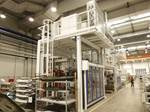Mini-autoclaves for visual carbon parts
This side story to CW's Plant Tour of Mubea Carbo Tech spotlights the company's mini-autoclaves.
Mubea Carbo Tech Salzburg’s Building 3 is the center for several of the company’s mini-autoclave programs, including a carbon seat shell for Porsche, which produces 16,000 parts (8,000 seats) per year in a twin-cavity steel tool. A mini-autoclave is a part-shaped piece of equipment, which integrates metal tooling and pressure vessel into a single unit, dedicated to one part. MCT uses automated cutters and nesting software to prepare prepreg kits for layup. Hand layed onto polyethylene (PE) slip sheets, the layups are then transferred into the mini-autoclave and vacuum bagged either with traditional vac-bag film or a reusable bag. The mini-autoclave is then hydraulically clamped shut and vacuum and 4 to 12 bar of air pressure are applied to compact laminate stacks ranging from 0.5 mm to several centimeters in thickness during a heated cure. Cycle times range from 15 to 60 minutes, depending on the size and complexity of the part. “The size of mini-autoclave parts is limited by legal requirements on pressure vessels,” explains Siegmann. “Once parts reach the size approaching that pressure limit, you must have a vessel the size of a normal autoclave.”
MCT Žebrák uses 60-80 mini-autoclaves (see photo at left), mainly for visual carbon parts, says Karas, for example a 0.5m by 2.5m spoiler. “Customers like visible carbon,” he adds, describing an MCT-patented transfer foil technology developed for cosmetics. These foils used on the CFRP surface provide a clear coat finish without secondary operations. “But this is just one possible way of achieving this,” notes Karas, who points out that painted surfaces must be equally high quality. He says the reusable bag technology used in the mini-autoclaves is also unique, developed with a supplier using a special silicone and textile reinforcement. Slavko claims each reusable bag can perform to specification for hundreds of cycles before it must be replaced.
This article is a sidebar to a feature story. To read the main article, click on "Mubea Carbo Tech: High-quality auto composits go high-volume" under "Editor's Pick's" at top left.
Related Content
-
Thermoplastic composites: Cracking the horizontal body panel nut
Versatile sandwich panel technology solves decades-long exterior automotive challenge.
-
Jeep all-composite roof receivers achieve steel performance at low mass
Ultrashort carbon fiber/PPA replaces steel on rooftop brackets to hold Jeep soft tops, hardtops.
-
Composites end markets: Automotive (2024)
Recent trends in automotive composites include new materials and developments for battery electric vehicles, hydrogen fuel cell technologies, and recycled and bio-based materials.












